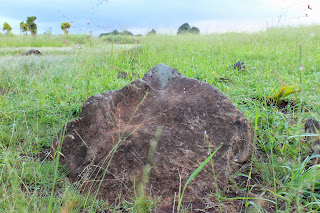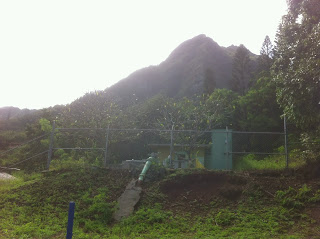My sister in law used to work at the Ilima Hotel years ago. She was still able to help accommodate a few friends of mine visiting the island during my wedding. I walked back with them to their room one night and found these four interesting paintings in the lobby. I brought up how each one had some deep meanings and my mainland friends made fun of it, leading to one of our own renditions of one of them.
The other day while riding around Waikiki I decided to revisit the hotel and share these. The artist is Ralph Kagehiro and they are each named with single words that evoke a deeper story to each...
I think the images should be interpreted in the opposite order. But I took them left to right instead of observing them from the front door heading into the hotel. So this is how I'm going to share them.
The first two images are of Lohiau and two different women. Lohiau was Pele's lover when she passed through Kauai. After setting up her home at Maui or Hawaii island. She asked her sister Hi'iaka to fetch him for her but not to fall in love with him. Hi'iaka makes an epic journey back across the archipelago disspelling all sorts of mythical creatures and villans. Including large mo'o, ruling chiefs, an even beautiful women that want to challenge her. All fall to the power of Hi'iaka. The journey takes so long that Pele becomes suspicious and destroys Hi'iaka's beloved forest. When they finally return, depending on the story teller. Hi'iaka and Lohiau realize they are in love and they sail off into eternity. The top image is Lohiau with Hi'iaka and the one below is him with Pele. As well as my good friends from San Francisco doing their own version....
If I could I'd buy this one and hang it in my house to stare at all day. I love the legend of Kane and Kanaloa. Two brothers. Kane of fresh water and Kanaloa of the ocean. Kane and Kanaloa travel the island and Kanaloa being the trickster, keeps getting Kane to produce water for them to drink and make awa with. Kane produces it over and over again across the land. Even in totally dry places. Or spewing out of a stone. They even come across a beautiful woman named Waiakeakua in Manoa and they both almost rush to overwhelm her. Just before she escapes into water herself.
Finally, or actually "the beginning." As it it titled. This image struck me at my second visit and is the reason why I thought it was special is this, in Olelo Hawaii Class with Kaipo'i. We just learned and are still mastering a creation legend. It starts with a fisherman that is enlightened by observing a spider and it's net. He learns netting and cordage and in turn. He can fish and create a better seagoing vehicle. Mankind takes advantage of this and migrates across the world. This happens somewhere near the equator and the Hawaiian word for the equator according to Kamehameha's very own navigator/star gazer actually means the path of the spider...


























































